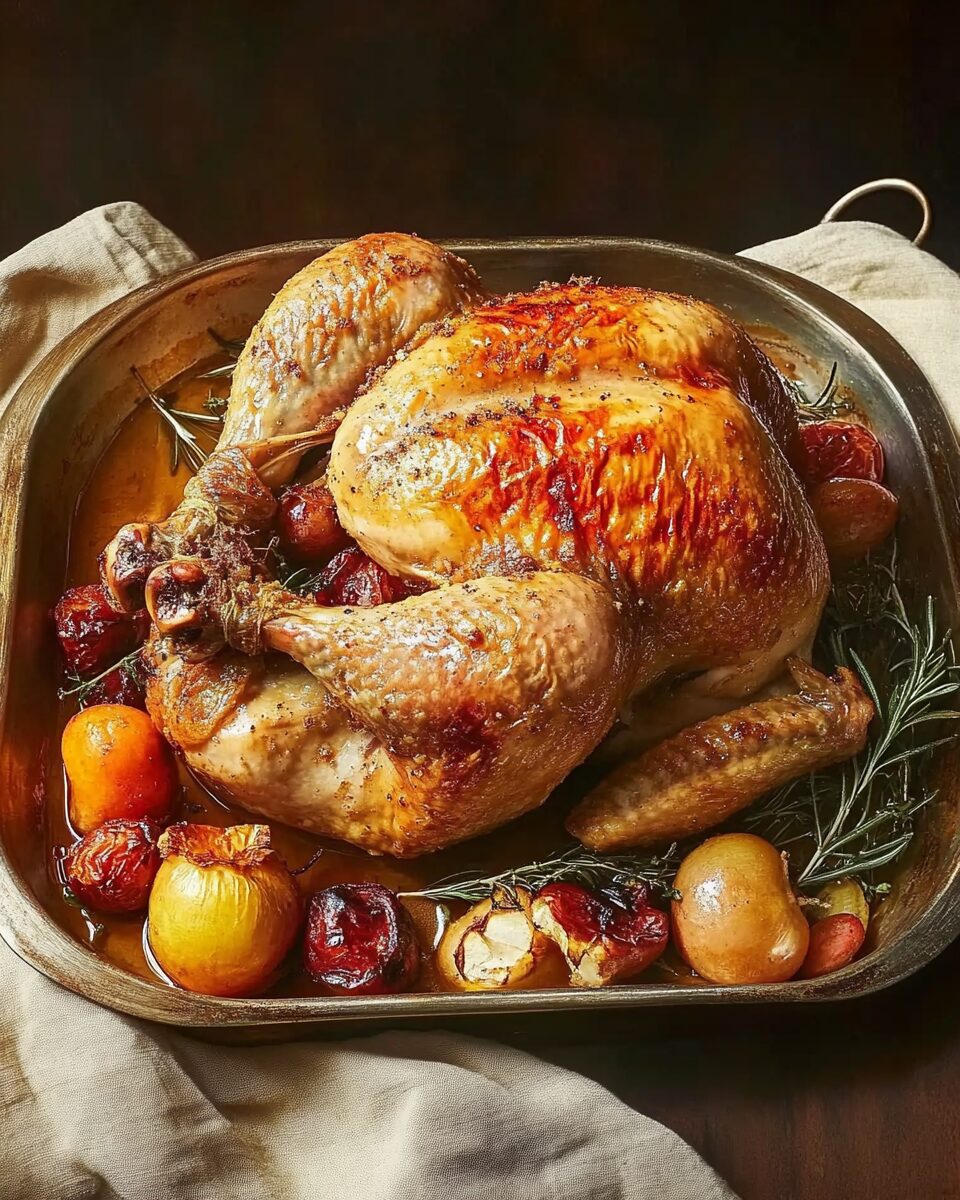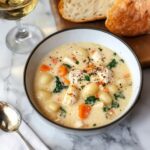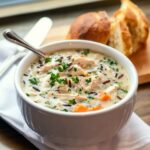This juicy roasted chicken is a classic dinner favorite that boasts a crisp, golden skin and tender, flavorful meat. Perfect for family meals or a special occasion, its simple blend of herbs and spices highlights the natural taste of the chicken while ensuring every bite is moist and satisfying.
Full Recipe:
Ingredients
- 1 whole chicken (about 3–4 lbs), giblets removed
- 2 tablespoons olive oil
- 1 teaspoon salt (adjust to taste)
- ½ teaspoon ground black pepper
- ½ teaspoon garlic powder
- ½ teaspoon onion powder
- ½ teaspoon paprika
- 1 lemon, halved
- 2–3 sprigs fresh rosemary (optional)
- 2–3 sprigs fresh thyme (optional)
Directions
- Preheat your oven to 450°F (230°C).
- Rinse the chicken under cold water and pat dry with paper towels.
- Rub the entire chicken with olive oil, ensuring both the exterior and the cavity are well coated.
- Season the chicken generously inside and out with salt, pepper, garlic powder, onion powder, and paprika.
- Place the lemon halves and, if using, the rosemary and thyme sprigs inside the cavity.
- Tie the legs together with kitchen twine and tuck the wing tips under the body to promote even cooking.
- Place the chicken in a roasting pan and roast in the preheated oven for 15 minutes.
- Reduce the oven temperature to 350°F (175°C) and continue roasting for an additional 45 minutes to 1 hour, or until the internal temperature reaches 165°F (74°C) at the thickest part of the thigh.
- Remove the chicken from the oven and let it rest for about 10 minutes before carving.
- Carve and serve to enjoy a delicious, juicy roasted chicken.
Nutrients
(Per serving, based on approximately 8 servings)
- Calories: ~250 kcal
- Total Fat: ~14 g
• Saturated Fat: ~3.5 g - Cholesterol: ~95 mg
- Sodium: ~350 mg
- Carbohydrates: ~1 g
- Protein: ~30 g
Introduction
Roasted chicken is more than just a meal—it’s an experience that brings families together and transforms a simple ingredient into a culinary masterpiece. This particular recipe for juicy roasted chicken has earned a special place in many kitchens for its perfect balance of crispy, golden skin and tender, flavorful meat. The magic behind the dish lies in its straightforward yet effective approach: enhancing the natural flavors of the chicken with a harmonious blend of herbs and spices, then carefully roasting it to lock in the moisture and aroma.
History and Background
Roasting meat has been a culinary tradition for centuries, and chicken, in particular, has a rich history in kitchens around the world. The technique of roasting is one of the oldest forms of cooking, dating back to ancient civilizations where open-fire cooking was common. Over time, as ovens became more refined and cooking techniques evolved, roasted chicken emerged as a dish that perfectly marries rustic simplicity with sophisticated flavors. Many cultures have developed their own versions of roasted chicken, each bringing unique seasonings and methods to the table. This recipe stands out by embracing a minimalist approach that allows the natural flavors of the chicken to shine while being subtly enhanced by a careful blend of herbs and spices. It’s a dish that resonates with both traditional comfort food and modern culinary artistry, making it a beloved recipe across generations.
The Art of Roasting Chicken
Roasting chicken to perfection is both an art and a science. The process involves more than just placing a bird in the oven—it requires attention to detail and an understanding of how heat interacts with meat. The goal is to achieve a harmonious balance where the skin becomes delectably crisp while the meat remains juicy and tender. One of the key techniques is managing the temperature during the cooking process. A high initial heat can help to crisp the skin and create a beautiful golden-brown appearance, while lowering the temperature later ensures the meat cooks evenly without drying out. The timing of these temperature adjustments is crucial and varies depending on the size of the chicken and the characteristics of your oven. By mastering these techniques, you can ensure that your roasted chicken always turns out perfectly, making it a reliable centerpiece for any meal.
Flavor Profile and Seasoning Philosophy
The beauty of this roasted chicken recipe lies in its simple yet effective seasoning approach. Rather than overwhelming the chicken with a complex array of spices, the recipe focuses on enhancing its natural flavor. The choice of herbs and spices is deliberate; each one is selected to complement the chicken without overpowering it. A light coating of olive oil helps the seasonings adhere to the skin, and the careful use of salt and pepper brings out the inherent savory qualities of the meat. Aromatic spices like garlic and paprika not only add depth but also create an enticing aroma that fills your kitchen during the roasting process.
Cooking Techniques and Tips for Success
Achieving the perfect roasted chicken is all about understanding and executing key cooking techniques. One essential tip is to start with a high oven temperature to help seal in the juices and create a crispy exterior. Once the skin has developed a rich color, reducing the heat allows the chicken to roast evenly, ensuring that the meat remains succulent and tender. Another important technique is to ensure that the chicken is thoroughly dried before seasoning. Moisture on the surface of the chicken can interfere with the browning process, so patting it dry with paper towels is a critical step.
Nutritional Benefits and Healthy Eating
Roasted chicken is not only a comfort food but also a nutritious addition to any diet. Chicken is a great source of lean protein, which is essential for muscle repair and growth, as well as overall bodily functions. The method of roasting, as opposed to frying or heavy sauce-laden cooking methods, ensures that the dish remains relatively low in fat while still delivering a satisfying taste. The natural juices of the chicken are preserved during roasting, providing beneficial nutrients such as vitamins and minerals that support a healthy immune system and contribute to overall well-being.
Versatility in the Kitchen
One of the greatest strengths of this roasted chicken recipe is its versatility. It serves as an excellent canvas for experimentation, allowing you to tailor it to your personal taste and dietary requirements. For instance, you can easily adjust the seasoning to reflect regional flavors or seasonal produce. In some variations, a squeeze of fresh lemon or a sprinkle of herbs like rosemary or thyme can add a burst of brightness to the dish. Additionally, the method of roasting can be adapted to suit different cooking equipment, whether you’re using a conventional oven, a convection oven, or even a rotisserie. This flexibility means that the recipe can be seamlessly integrated into various culinary traditions, from a classic Sunday roast to a festive holiday meal.
Serving Suggestions and Pairing Ideas
Roasted chicken pairs beautifully with a wide range of side dishes, making it a versatile option for any meal. Traditionally, it is often accompanied by roasted vegetables such as carrots, potatoes, and Brussels sprouts, which can be cooked in the same oven to absorb the delicious flavors of the chicken drippings. A light, refreshing salad can also serve as a perfect counterbalance to the richness of the roasted meat. For those looking to elevate their dining experience, consider pairing the dish with a robust red wine or a crisp white wine, depending on your preference.
Storing and Reheating
One of the practical advantages of roasted chicken is its ease of storage and versatility as leftovers. When properly stored, roasted chicken can maintain its flavor and texture for several days in the refrigerator. It can be used in a variety of dishes throughout the week—from hearty sandwiches and salads to soups and casseroles—ensuring that nothing goes to waste. To preserve the juiciness and prevent the meat from drying out, it is best to store the chicken in an airtight container. Reheating can be done gently in the oven or on the stovetop; this method helps retain the crispy skin and moist interior. Some cooks even recommend reheating slices of chicken in a skillet with a little bit of broth to reintroduce moisture. The ease of repurposing roasted chicken into new meals not only saves time but also adds an element of creative flexibility to your meal planning, allowing you to enjoy its delicious flavors in multiple forms.
Common Mistakes to Avoid
While roasting a chicken may seem straightforward, there are several common pitfalls that can detract from an otherwise perfect dish. Overcooking is one of the most frequent issues, as it leads to dry, stringy meat. It is crucial to monitor the internal temperature closely and remove the chicken from the oven as soon as it reaches the safe cooking threshold. Another common mistake is failing to dry the chicken thoroughly before seasoning. Excess moisture on the surface can prevent the skin from crisping up properly. Additionally, using too much seasoning or an imbalance of spices can overwhelm the natural flavor of the chicken, turning a simple dish into something overly complex and muddled.
The Joy of Home Cooking
There is a unique joy in preparing a meal from scratch, and roasting a chicken is one of the most rewarding endeavors a home cook can undertake. The process is meditative, from the careful selection of a quality chicken to the thoughtful preparation and roasting, every step is infused with the promise of a satisfying meal. Cooking at home not only allows you to control the quality of the ingredients but also gives you the freedom to experiment and make the recipe your own.
Conclusion
In conclusion, this roasted chicken recipe is a celebration of simplicity, flavor, and versatility. It captures the timeless appeal of a dish that has been enjoyed across cultures and generations while incorporating modern techniques to ensure maximum flavor and juiciness. From its rich history and meticulous cooking methods to its impressive nutritional benefits and adaptability in the kitchen, every aspect of this recipe reflects the care and thought that goes into home-cooked meals.






